The American Fitness Obsession Has Made Its Way to France—but Something Has Gotten Lost in Translation
The words were written neatly in purple chalk on a Left Bank stretch of the Seine where said fitness compétents gather to huff and puff through burpees and boxing sessions. I wish I had stopped running to snap a picture. But only a few days into my six-month Parisian stint, I didn’t realize what a perfect entree those words—addressing an English-speaking exerciser with an American movie reference (Home Alone, remember?) provided to the newly happening Parisian boutique fitness scene.
The writing really is on the workout wall: in the city memorably mocked by New Yorker writer Adam Gopnik for being so oblivious to exercise that health clubs handed out chocolate truffles and didn’t even offer memberships that allowed multiple workouts a week—things are changing.
Ten years ago, I got looks like I was fleeing the scene of a crime when I went out for a simple jog along the Seine; today there’s sufficient demand for fitness to fuel a fledgling studio scene.
Ten years ago, I got looks like I was fleeing the scene of a crime when I went out for a simple jog along the Seine; today there’s sufficient demand for fitness to fuel a fledgling studio scene.
As an American who’s equal parts Francophile and fitness buff, I can testify that the passionate pursuit of sweat long familiar in the United States has officially crossed the Atlantic: I visited 15 fitness studios here in the last six months, and the influences are as unmistakably American as the execution is fully French.
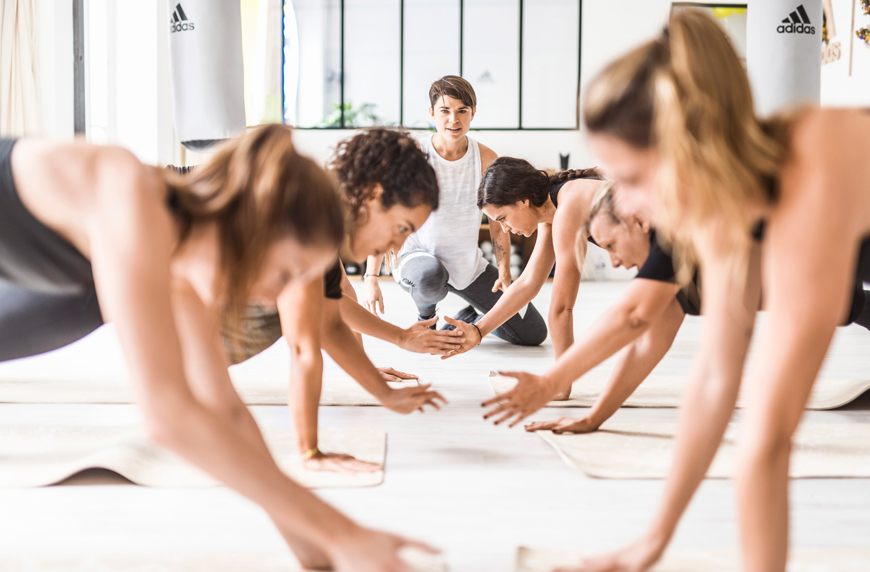
Parlez-vous fitness??
Let’s start with the language of French fitness.

{{post.sponsorText}}
I admit I was disappointed when an otherwise excellent hot vinyasa class at Snake and Twist in the 16th Arrondissement was taught entirely in English. (I didn’t study French all those years not to be able to show off my comprehension of chien tête en bas!) But when I whined to my friend and expat fitness instructor Jess King, she gently explained that her French clients come to her classes across Paris in part because they’re taught in English. “It’s part of the authentic experience; fitness is an American product here.” (King teaches her signature HIIT class TNL58’ in a very appealing franglais, outdoors on the Place St. Honoré, on the Champs de Mars in front of the Eiffel Tower, and at Hôtel Parister and Chez Simone, two trendy locations frequented by a growing group of fitness-fascinated Parisians.)
She had a point. My preferred stomping (or sweating) ground, the sexily lit treadmill-and-weights workout Bootcamp Midtown , with locations in the 8th and 1st arrondissements, explicitly advertises itself as au style new yorkais. The Parisian outpost of barre brand the Dailey Method, in the 16th arrondissement, promises a surefire path to getting en forme californienne.
Maybe showing up to a fitness studio in Paris and expecting a thoroughly French experience is like taking offense that the Champs-Elysées McDonald’s doesn’t serve pain au chocolat?
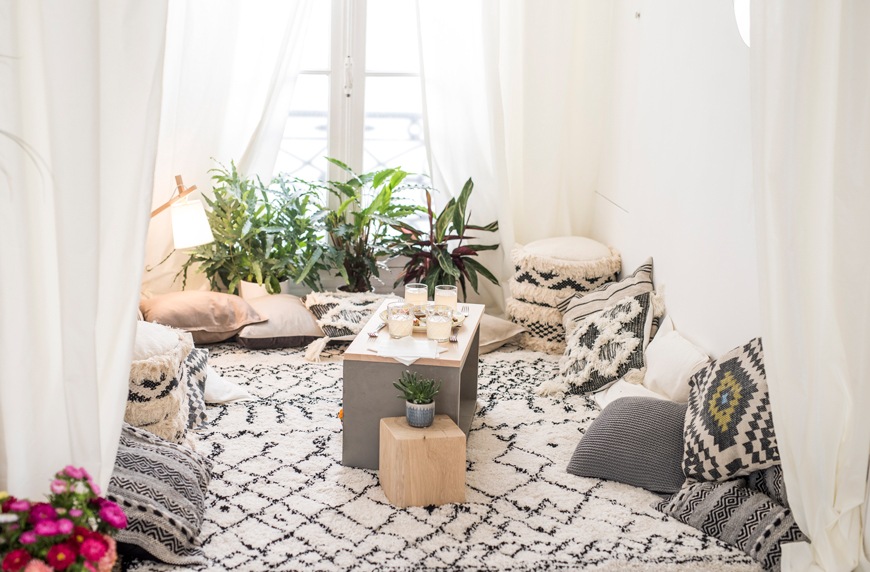
That said, Dailey Method manager Sarah Vinoche taught a class so fluidly in perfect French and English—and barre cues are precise and prolific—that pulsing en pointe for the eternity she demanded seemed easy by comparison. In my experience, Vinoche’s bilingual skill was rivaled only by Benjamin Beirs’ vinyasa class at the airy, gorgeous Paris Yoga Shala, located in the 8th arrondisement; he not only cued and delivered little philosophical lectures in both languages between directions but also threw in Sanskrit, speaking what is the international language of yoga (or at least one equally incomprehensible to many of the casual yogis in the class—French or otherwise).
The multitasker in me was excited to experience fitness as French language immersion, but it was harder than I thought. Back at Snake + Twist yoga, I ended up in the corner of a class taught in rapid-fire French by owner Marcia Segal. Following the French cues when I couldn’t see Segal was almost as hard as keeping up with it-girl Clotilde Chaumet’s literally underground TIHHY (Très Intense Hip Hop Yoga), which involves tough poses taught at a quick clip to loud hip-hop, in almost total darkness. I definitely bragged about what felt like a real insider Parisian experience—TIHHY is waitlist-only, has its own fashion line, and is held in a subterranean Nike space that involves navigating unmarked tunnels to reach. (I was so determined to try it, I attended during a rare Parisian snowstorm!) At MIRZ Yoga in the 19th arrondissement, the absence of music and presence of hands-on adjustments in the class I took made the experience more accessible (and visually pleasing in a different way; big windows look out on a calming, leafy garden).
I’ve learned the hard way that indoor cycling classes are the easiest fitness formats to follow in French.
I’ve learned the hard way that indoor cycling classes are the easiest fitness formats to follow in French. Dynamo, (where Chaumet is a head trainer), features relatively complex SoulCycle-style choreography at its four locations, but there just aren’t that many moves you can execute sitting upright and clipped into a bike. Plus, it’s far easier to follow with the instructor (and other riders) in view as opposed to staring at the floor en planche in yoga or in a HIIT class praying you’ll understand the next cue. (Indoor cycling studio KIWILL in the trendy 11th arrondissement, and Chez Simone also indicate when classes are in English on their schedule.)
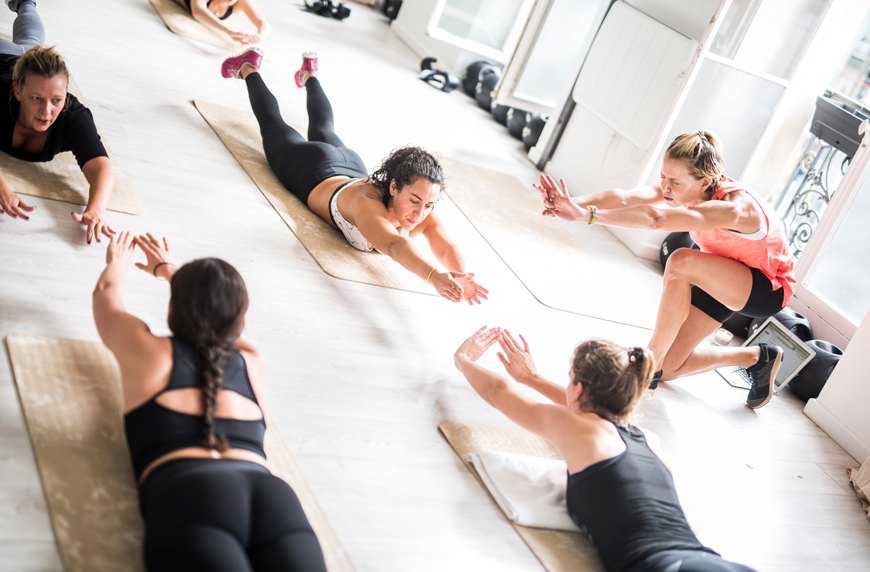
Interestingly, when English shows up on the boutique fitness scene, it’s often the kind that could only exist outside of the United States. At sleek Bootcamp Midtown, the incongruously ‘roid-ragey “MOVE YOUR FUCKING ASS!” is splashed across the wall, hashtagged on social media, and even printed on apparel. Pardon our French. At similarly luxurious fitness studios in the States, it’s not unusual for some clients (AKA uptight Americans) to complain about a few curse words uttered in a single song played in a 45-minute class.
At KIWILL, where I attended a GOOD MOOD ride with French fitness Instagram star Lucie Agras, the storefront is stenciled with “MAKE YOUR WORKOUT GREAT AGAIN.” LOL but not really: If Trump is actually your president, a lighthearted shout-out to the exercise-hating executive is a quick way to kill your vibe.
But apparently not if you’re French! Lucie’s class is the only one in Paris where the repartee with her riders was so high-energy that students burst out in the unrestrained “WOOOHOO!”s. I hadn’t noticed those were so standard in American fitness classes until working out in Paris, where class-goers are almost utterly silent, and there are hardly any end-of-class sweaty high-fives. Except for Lucie’s session and a Chez Simone dance class with Olivia Courbis that involved an impressive amount of free styling and an invitation to CHANTEZ! to Whitney Houston’s “I Wanna Dance with Somebody” (we all obliged), I witnessed virtually no back-and-forth between students and instructors. Mais pourquoi?
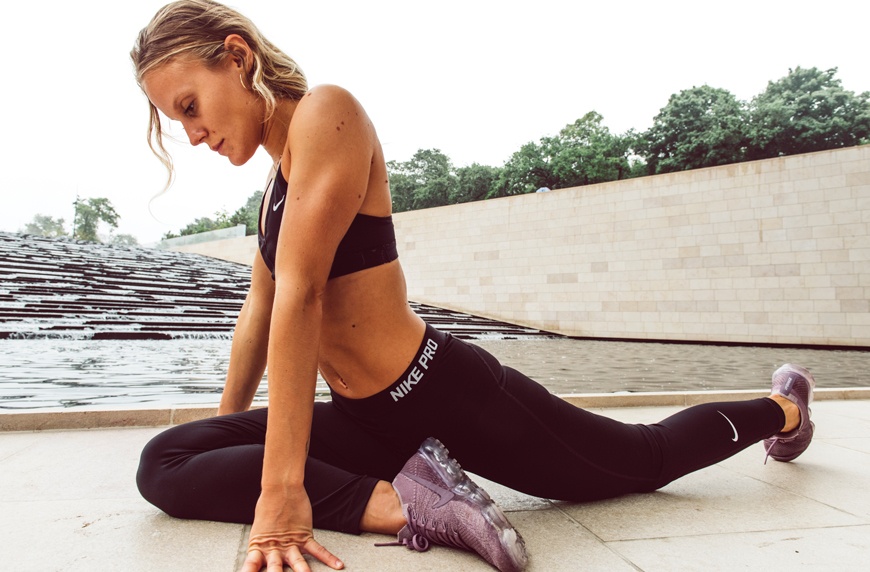
Why would anyone want to look like they're going to the gym?
Despite the city’s emerging boutique fitness scene, a savvy observer may get the sense that unlike in the United States, exercise is still considered a little uncivilized in Paris. Perhaps socializing in class would normalize that fact that we are all actually there, together, admitting we are engaged in—paying for, and maybe even enjoying— this bizarre sweaty ritual. The absence of the instructor’s “HOW YOU FEELING TODAY, PEOPLE?” might come from fear of silence, or of what the answer could be in a culture only beginning to embrace exercise as something positive rather than necessary evil.
Consider that when French President Nicolas Sarkozy was spotted jogging in 2007, philosopher Alain Finkielkraut sniffed, “I’d rather see the president in his suit than his sweat.” Contrast that with the U.S., where presidential performances of physical fitness, from Jimmy Carter jogging to Barack Obama hitting a hotel gym have for decades been an easy way to score political points.
French women may be showing up in greater numbers to spin, stretch, lift, and run, but in the capital of global fashion, the gym is not (yet?) considered a runway.
In my own low-key version of this dynamic, I made an offhand comment to a French friend that American women often wore workout clothes not only for comfort and style but also to display their disciplined commitment to exercise, and she asked earnestly, “But why would anyone want to look like they are going to the gym?”
Sure enough, the chic French women I saw dressing in Chanel and Hermes in the locker room—and who had just paid 30 euros for a 45 minute exercise class—surprisingly sported simple (and sometimes worn-out) spandex in the gym. Not a stitch of high-end athleisure like Alo or Outdoor Voices to be seen, and only a little bit of Lululemon, though the brand has opened three Paris locations. French women may be showing up in greater numbers to spin, stretch, lift, and run, but in the capital of global fashion, the gym is not (yet?) considered a runway.
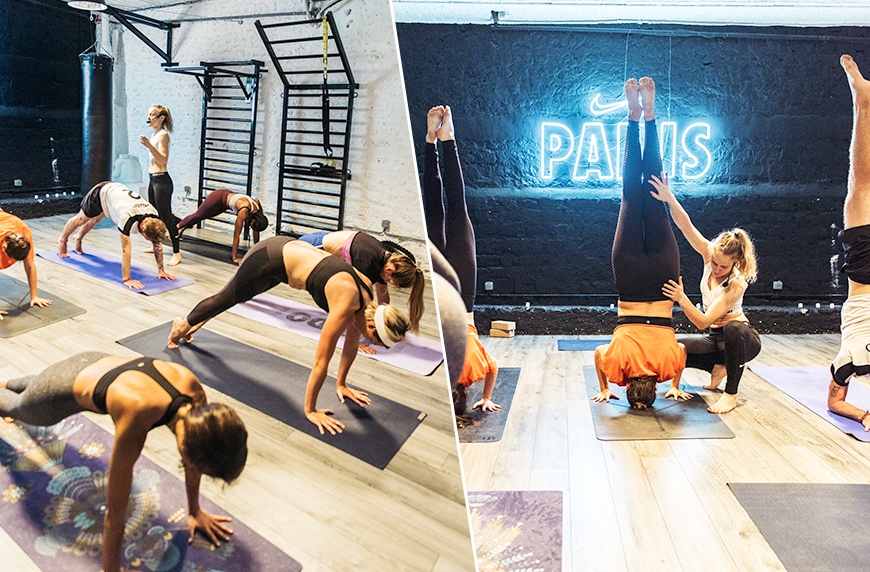
Body Booster in the posh 16th arrondissement has built an entire business based on the assumption that in an ideal world, icky exercise would be avoidable, rather than plastered all over Instagram. For my visit, a chatty trainer helped me into a special, conductive suit and connected me to a machine that delivered electric currents into my muscles, promising to achieve in twenty minutes l’effet de trois heures du sport (translation: the results of a three-hour workout)—but basically without moving, and certainly without sweating. It reminded me of the passive “reducing machines” of the mid-20th century that were marketed as allowing women to “relax in luxurious comfort”—rather than participate in rigorous exercise considered unladylike—while their fat melted away, often while they kept their heels on. (I was barefoot.) That underlying attitude still seems to exist in France: exercise is unfortunately necessary for health and beauty, but itself is unsavory.
That underlying attitude still seems to exist in France: exercise is unfortunately necessary for health and beauty, but itself is unsavory.
If the American boutique fitness world has decided diet talk is déclassé or at least out-of-step with our exercise-as-empowerment messaging, the takeaway in the French class landscape has been lost in translation. While it pushes my feminist outrage buttons, I was intrigued to see that examples abound: The otherwise-en francais yoga class at Snake + Twist featured the one English phrase that in the United States has become shorthand for outdated attitudes about exercise and aesthetics: le bikini body, c’est cool!
At Le Tigre’s Chaillot location, I was transported to the early ‘90s when an instructor (who was likely not yet born in the early ‘90s) teaching an English-language sculpt class urged us to listen hard if we wanted to lose our “muffin tops” and then asked for volunteers to translate the phrase into French between leg lifts. (“avoir de la brioche au ventre” is the equivalent use of baked goods to signify belly fat).
At Waterbike, a 21st-century update on an old French tradition of hydrotherapy spa “slimming” techniques, I enclosed myself in a giant, shoulder-high bathtub to pedal on a stationary bike submerged in churning water. As I prepared for the promised drainage (to combat fluid retention) to transpire, I asked the impeccably dressed, rail-thin attendant if I could use the heavier (2 kilo/4.4 pound) set of hand weights I saw stacked behind the reception desk. “Mais Madame,” she cautioned as she reluctantly handed them over and eyed my biceps, “Vous savez que ça va vous faire toujours plus musculée?” She was warning me—at a fitness studio—that lifting weights might result in making me “even more muscular”! That, I am aware.
A next level mind-body connection
My favorite French take on the fitness scene (unsurprisingly, given I’m a professor and a gym rat) is how the country’s more intellectual sensibilities seep into even the most thoroughly physical project—working out—in a way that’s unimaginable in the United States.
At ICI Self Care, owner Sam Guelimi advertises yoga, harmonie, et littérature as if the three are intuitively intertwined. She works from the charming duplex as both a literary editor and a yoga instructor, and invites students to relax and browse her library before and after class. Instead of separating her mind-body passions into “side hustles,” she unites them in a unique environment dedicated to soin de soi (“self-care”). The evening I attended a relaxing flow class, everyone lingered to page through photography volumes and novels and to chat over complimentary coconut tea.
It says something that a fitness studio sees midcentury feminist philosophy as an effective way to entice people into HIIT and TRX classes.
Chez Simone, easily the most instagrammable wellness space in Paris also features a library (and a healthy snack bar and an Adidas boutique) and is named for philosopher Simone de Beauvoir, activist Simone Veil, and film star Simone Signoret. The model is resonating, as they’re relocating in a larger location in the 2nd arrondissement in early September.
Even if you consider this the French version of “empowertising,” a term coined by feminist Andi Zeisler to mean the cynical marketing of a shallow version of “empowerment,” it says something that a fitness studio sees midcentury feminist philosophy as an effective way to entice people into HIIT and TRX classes. While Chez Simone, with its pale pink decor and pro-woman purpose, is reminiscent of the buzzy women’s club The Wing (which is also scouting Paris real estate), can you imagine any American fitness empire positioning itself as carrying on the legacies of Susan B. Anthony or Betty Friedan?
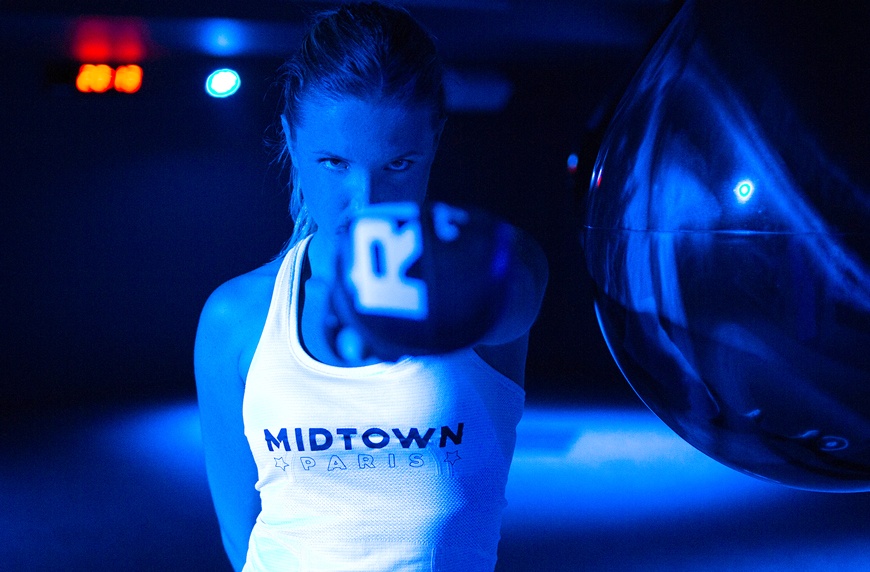
What does it mean to work out like the French?
Almost two decades ago, Gopnik recounted his adventures trying to find an “American-style gym” in Paris. Seeking a swim workout, he found fellow bathers munching tea sandwiches poolside, and at the club he finally joined, les appareils (machines) Nautilus gleamed, untouched, like precious museum pieces. In 2018, that workout scene is evolving; the fifteen fitness spots I hit hardly encompass the multiplying options just in the boutique space—and don’t even include membership clubs like L’Usine, Health City, and Keep Cool.
Yet it’s slow-going. Most classes I’ve attended had fewer than ten participants, and the majority of the studios were too small to accommodate many more. I’ve crossed the city in search of a weekend class beginning before 11 a.m., and signed up for a class at a lesser-known studio that was canceled at the last minute due to low enrollment. On holidays (and there are a lot in France), many studios shut down, suggesting that working out—even by the subset who spend substantially on boutique fitness—is not quite the leisure pursuit it’s become in affluent American cities.
Bootcamp Midtown became my go-to workout for one reason: it was the most physically demanding class I could find. That’s thanks to sprints while carrying sandbags (and doing metric conversions!), epic squat sequences, and elaborate bodyweight exercises. Midtown is differentiated from competitors that offer community and amenities, but which seem surprisingly unconcerned with the familiar fitness industry competition of who’s-the-hardest.
Even its founder Emmanuel Pothier says he left finance for fitness to “take care” of (rather than torture) the devoted followers who trek to the two locations for an experience that, based on my breathless after-class conversations, also attracts a smattering of in-the-know tourists and globetrotting fashion types seeking the closest equivalent to a Tone House or Barry’s Bootcamp. Barry’s, for that matter, is expanding its European footprint to open soon in Paris at the crosspoint of the Montergueil/Les Halles/Marais neighborhoods. So potentially things are going to get sweatier.
The new studio scene is proof positive that the days when Parisian culture conspired to keep Gopnik from getting a good sweat are long gone. But unlike fashion, beauty, cooking, and sex, areas where we Americans unfailingly aspire to imitate the French, Parisian fitspo in its current form feels a lot like an American export. For now.
Of course, if you're going to France to vacation (or anywhere else for that matter), here are three notes to take and here's the French-girl approved way to shower.
Loading More Posts...